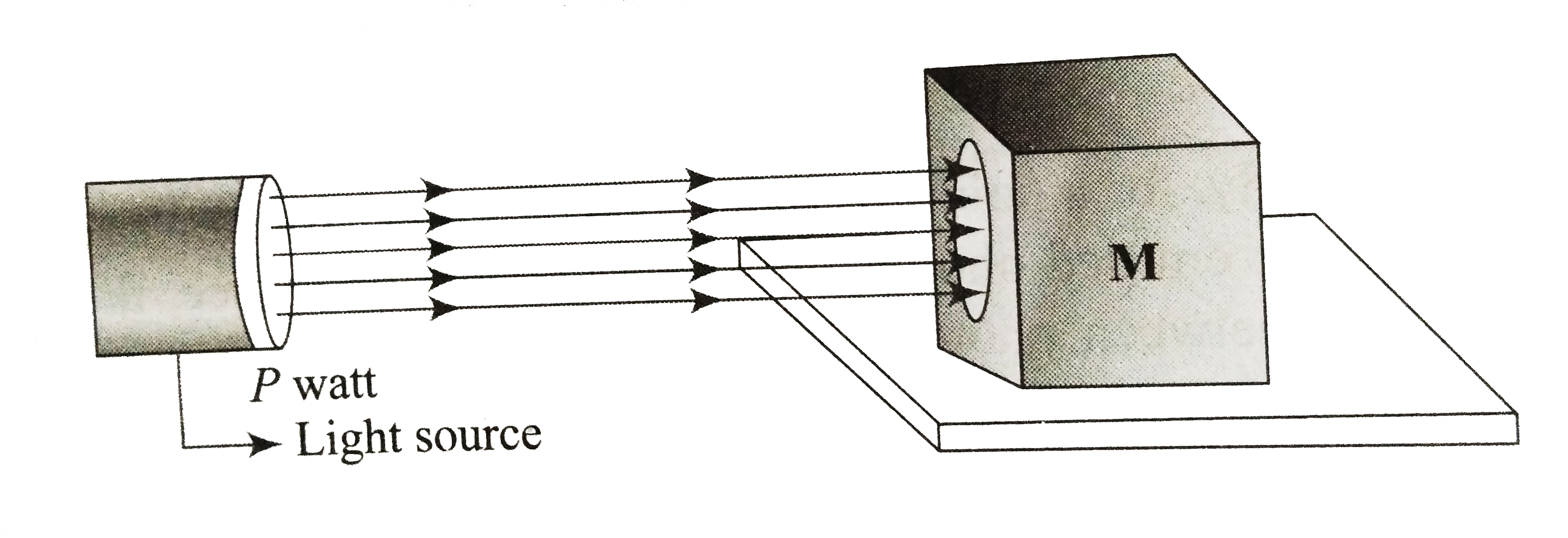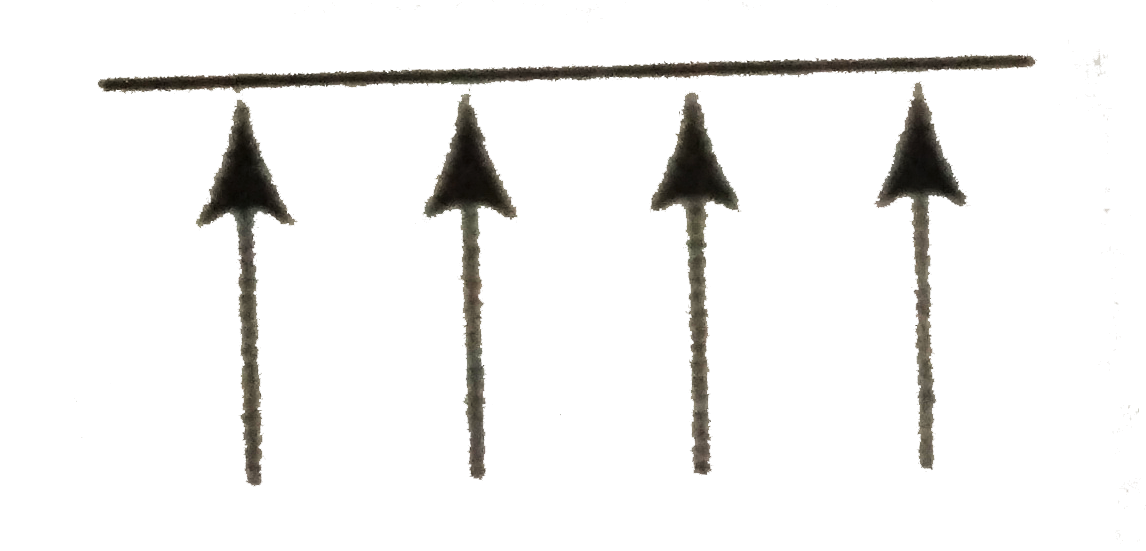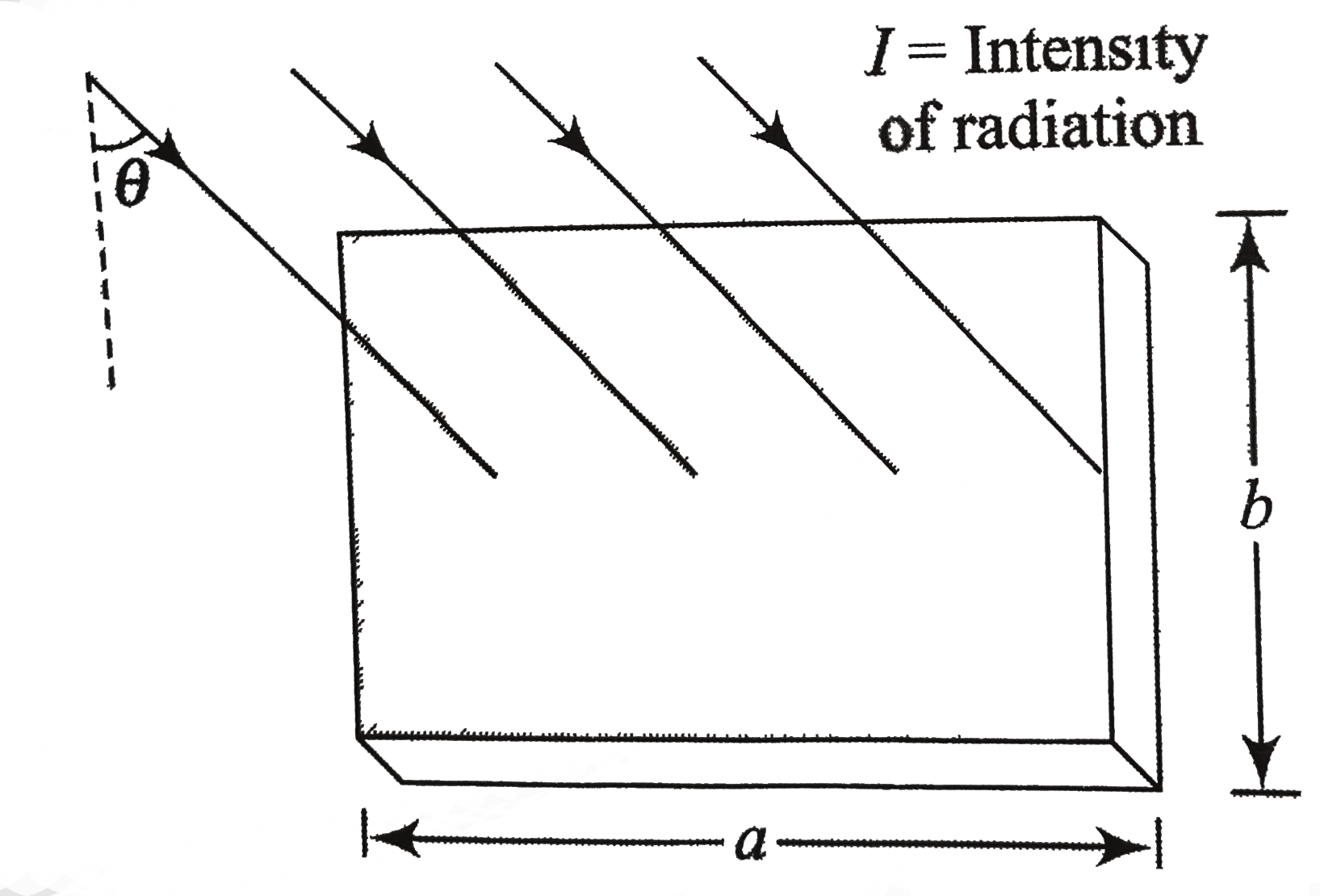Examples from CENGAGE PHYSICS (ENGLISH) PHOTOELECTRIC EFFECT for Class 12
| Class 12 | PHYSICS |
| Chapter | PHOTOELECTRIC EFFECT |
| CENGAGE PHYSICS (ENGLISH) | Examples |
| Medium | English |
| Academic Year | 2023-2024 |
Question 2
The sun delivers about 1.4kWm−2 of electromagnetic flux to the earth's surface. Calculate
A. the total power incident on a roof of dimensions 8m×20m.
B. the solar energy in joules incident on the roof in 1h.
C.the radiation pressure and force assuming the roof to be a perfect absorber.View SolutionQuestion 4
The sun gives light at the rate of 1400Wm−2 of area perpendicular to the direction of light. Assume λ(sunlight)=6000A. Calculate
A.the number of photons per second arriving at 1m2 area at earth.
B. the number of photons emitted from the sun per second assuming the average radius of the Earth's orbit is 1.49×1011 m.View SolutionQuestion 12

A toy truck has dimensions as shown in fig. and its width, normal to the plane of this paper, is d. The sun rays are incident on it as shiwn in the figure. If intensity of rays is I and all surfaces of truck are perfectly black, calculate tension in the thread used to keep the truck stationary. Neglect friction.View SolutionQuestion 18
A. For what kinetic energy of neutron will the associated de Broglie wavelength be 1.40×10−10m?
B. Also, find the de Broglie wavelength of a neutron, in thermal equilibrium with matter, having an average kinetic energy of (32) kT at 300K. Given the mass of neutron=1:66×10−27kg and k=1.38×10−23Jkg−1.View SolutionQuestion 19
An electron microscope uses electrons accelerated by a voltage of 50 kV. Determine the de Broglie wavelength associated with the electrons. If other factors (such as numerical aperture, etc.) are taken to be roughly the same, how does the resolving power of an electron microscope compare with that of an optical microscope which uses yellow light?View SolutionQuestion 21
The extent of localization of a particle is determined roughly by its de Broglie wave. If an electron is localized within the nucleus (of size about 10−14m) of an atom, what is its energy? Compare this energy with the typical binding energies (of the order of a few MeV) in a nucleus and hence argue why electrons cannot reside in a nucleus.View SolutionQuestion 25
A mercury lamp is a convenient source for studying frequency dependence of photoelectric emission, since it gives a number of spectral lines ranging from the UV to the end of the red visible spectrum. In our experiment with rubidium photocell, the following lines from a mercury source were used: λ1=3650A∘,λ2=4047A∘,λ3=4358A∘,λ4=5461A∘,λ5=6907A∘ The stopping voltages, respectively were measured to be:
V01=1.28V,V02=0.95V,V03=0.74V,V04=0.16V,V05=0V.
(a) Determine the value of Planck's constant h.
(b) Estimate the threshold frequency and work function for the material.View SolutionQuestion 26
Photoelectric threshold of silver is λ=3800A. Ultraviolet light of λ=2600A is incident of a silver surface. Calculate:
a. the value of work function in joule and in eV.
b. maximum kinetic energy of the emitted photoelectrons.
c. the maximum velocity of the photoelectrons.
(Mass of the electrons=9.11×10−31).View SolutionQuestion 28
When a surface is irradiated with light of wavelength 4950A, a photoncurrent appears which vanishes if a retarding potential greater than 0.6 V is applied across the photo tube. When a different source of light is used, it is found that the critical retarding potential is changed to 1.1 V. Find the work function of the emitting surface and the wavelength of the second source. If the photoelectrons (after emission from the surface) are subjected to a magnetic field of 10 T, what chages will be observed in the above two retarding potentials?View SolutionQuestion 30
A beam of light has three wavelengths 4144Å, 4972Å and 6216Å with a total instensity of 3.6×10−3Wm−2 equally distributed amongst the three wavelengths. The beam falls normally on an area 1.0cm2 of a clean metallic surface of work function 2.3 eV. Assume that there is no loss of light by reflection and that each energetically capable photon ejects on electron. Calculate the number of photo electrons liberated in two seconds.View SolutionQuestion 31
A photocell is operating in saturation mode with a photocurrent 4.8mA when a monochromatic radiation of wavelength 3000Åand power of 1mW is incident. When another monochromatic radiation of wavelength 1650Å and power 5mW is incident, it is observed that maximum velocity of photoelectron increases to two times. Assuming efficiency of photoelectron generation per incident photon to be same for both the cases, calculate.
(a) the threshold wavelength for the cell
(b) the saturation current in second case
(c ) the efficiency of photoelectron generation per incident photon.View SolutionQuestion 33
Light of wavelength 2000Å falls on an aluminium surface . In aluminium 4.2eV of energy is required to remove an electron from its surface. What is the kinetic energy , in electron volt of (a) the fastest and (b) the slowest emitted photo-electron . ( c) What is the stopping potential ? (d) What is the cut - off wavelength for aluminum? (Plank's constant h=6.6×10−34J−s and speed of light c = 3 xx 10^(8) m s^(-1).View SolutionQuestion 35
a. A stopping potential of 0.82V is required to stop the emission of photoelectrons from the surface of a metal by light of eavelength 4000A. For light of wavelength 3000A, the stopping potential is 1.85V. Find the value of Planck's constant. [1 electrons volt (eV)=1.6×10−19J]
b. At stopping potential, if the wavelength of the incident light is kept fixed at 4000A, but the intensity of light increases two times, will photoelectric current be botained ? Give reasons for your answer.View SolutionQuestion 36
A 40 W ultraviolet light source of wavelength 2480A. Illuminates a magnesium (mg) surface placed 2 m away. Determine the number of photons emitted from the surface per second and the number incident on unit area of Mg surface per second . The photoelectric work function for Mg is 3.68eV. Calculate the kinetic energy of the fastest electrons ejected from the surface. Determine the maximum wavelength for which the photoelectric effects can be observed with Mg surface.View SolutionQuestion 38
Light form a dicharge tube containing hydrogen atoms falls on the surface of a piece of sodium. The kinetic energy of the fastest photoelectrons emitted from sodium is 0.73 eV. The work function for sodium is 1.82 eV. Find (a) the energy of the photons causing the photoelectrons emission.
(b) the quantum numbers of the two levels involved in the emission of these photons.
(c ) the change in the angular momentum of the electron in the hydrogen atom, in the above transition, and
(d) the recoil speed of the emitting atom assuming it to be at rest before the transition. (lonization potential of hydrogen is 13.6 eV.) View SolutionQuestion 39
Photoelectrons are emitted when 400nm radiation is incident on a surface of work - function 1.9 eV. These photoelectrons pass through a region containing α-particles. A maximum energy electron combines with an α -particle to from a He+ ion, emitting a single photon in this process. He+ ions thus formed are in their fourth excited state. Find the energies in eV of the photons lying in the 2 to 4 eV range, that are likely to be emitted during and after the combination. [Take,h=4.14×10−15eV−s] View Solution


